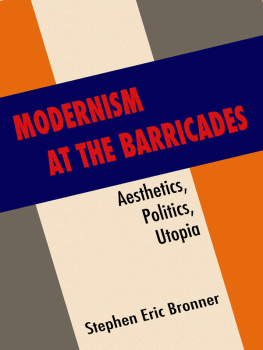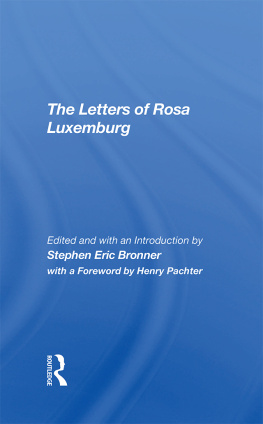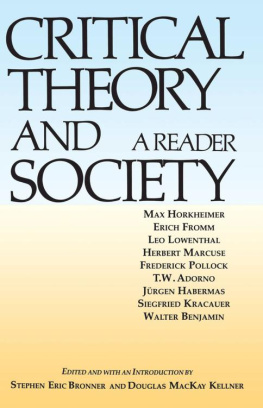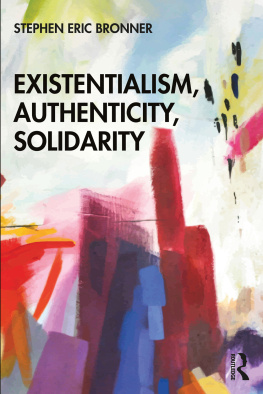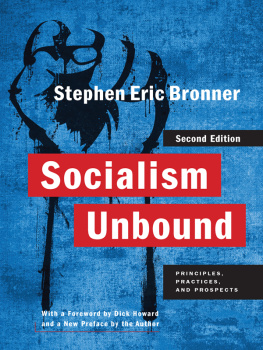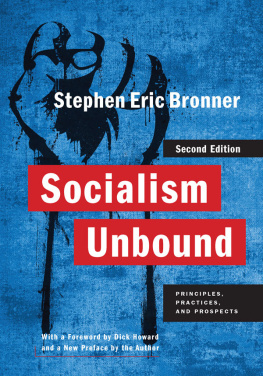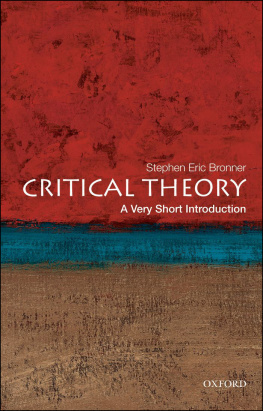The Bigot
The Bigot
Why Prejudice Persists
Stephen Eric Bronner

Copyright 2014 by Stephen Eric Bronner.
All rights reserved.
This book may not be reproduced,
in whole or in part, including illustrations, in any form (beyond that copying permitted by Sections 107 and 108 of the
US Copyright Law and except by reviewers for the public press), without
written permission from the publishers.
Yale University Press books may be purchased in quantity for educational,
business, or promotional use. For information, please e-mail
sales.press@yale.edu (US office) or sales@yaleup.co.uk (UK office).
Set in Janson type by Integrated Publishing Solutions.
Printed in the United States of America.
Library of Congress Cataloging-in-Publication Data
Bronner, Stephen Eric, 1949
The bigot : why prejudice persists / Stephen Eric Bronner.
pages cm
Includes bibliographical references and index.
ISBN 978-0-300-16251-6 (hardback)
1. Prejudices. 2. Toleration. 3. Political sciencePhilosophy. I. Title.
HM1091.B76 2014
303.385dc23 2013047875
A catalogue record for this book is available from the British Library.
This paper meets the requirements of ANSI/NISO Z39.481992
(Permanence of Paper).
10 9 8 7 6 5 4 3 2 1
To my uncle and aunt, Herman and Lore Haller
There is nothing more frightening than ignorance in action.
Johann Wolfgang von Goethe
Hatred alone warms the heart.
Umberto Eco
Contents
ONE
Modernity
TWO
Mythological Thinking
THREE
Playing the Role
FOUR
The Bigot Today
Acknowledgments
There are many who contributed to this manuscript. My friends Philip Green, Jeffrey Isaac, Edward Ramsamy, and Cornel West offered valuable insights and comments. George Castiglia and Beth Breslaw participated in a seminar devoted to The Bigot that was attended by a number of my graduate students: Karie Gubbins, Bill Hwang, Douglas Irvin-Erickson, Edwin Daniel Jacob, Megan Unden, and Sarah Weirich. I would also like to thank my research assistant, Bailey Socha, my manuscript editors, Laura Jones Dooley and Julie Carlson, and especially William Frucht, my editor at Yale University Press, for their help in bringing this work to fruition. Finally, I want to express my gratitude for the ongoing support and enthusiasm shown by my colleagues Alex Hinton and Nela Navarro at Rutgerss Center for the Study of Genocide and Human Rightsas well as by my wife: Anne Burns.
The Bigot
Introduction
The Bigot was finished a few days after the reelection of President Barack Obama in 2012. I had already begun thinking about a book of this sort shortly after his initial victory in 2008. It was seen by much of the radical right as representing the triumph of multicultural radicalism bolstered by a new vanguard of elite, cosmopolitan urban intellectuals and people of colorall with liberal values and socialist hopes. From the moment that Barack Obama entered the White House in 2008, Senate Minority Leader Mitch McConnell (R-Kentucky) stated bluntly that the primary goal of the Republican Party was to block the new administration and ruin any chance that the nations first black president might have for reelection. Action at the grassroots accompanied this agenda. Fueled by the rhetoric of Fox News and media demagogues like Rush Limbaugh, Glenn Beck, and Michael Savage, and inspired by evangelical fundamentalism, far-right groups routinely began referring to Barack Obama as the affirmative action president, the food stamp president, an imam, and the Antichrist. His election would, it was claimed, lead radical Islamists to dance in the streets. He was excoriated as an African American (more African than American) who lacked a birth certificate, gained his position illegally, and was complicit in planning the takeover of the United States by the United Nations. Posters and advertisements identified Obama with Hitler, placed his head and that of his wife on the body of chimpanzees, portrayed the White House with rows of watermelons on the lawn, and implied that the president was a crack addict. The problem apparently was not with prejudiced whites who hated blacks but rather with the sophisticated black intellectual who had (always) hated whites. The language of intolerance seemed to have gained a new dialect, one that achieved legitimacy and acceptance among a growing public.
While writing this volume, I often thought of Tyler Clementi, a gay music student at Rutgers University who committed suicide after learning that his roommate had taped his sexual encounter with another man and then spread it across the Internet. Tensions at Rutgers, where I teach, simmer between Muslim students uncritical of their own prejudices and elements of the Jewish community who apparently think that Cossacks are readying themselves for the next pogrom. Intimidated immigrant students huddle together in lunchrooms and cafs. Snickers are audible when a transgender person walks by. Religious intolerance and unease over gay marriage are more common than many might think. Too many young people are skeptical about government policies helpful to a working classand a working poorthat is no longer white. Even while courses on cultural understanding multiply, and interracial dating has become more acceptable, bigotry flourishes. The university may have its written and unwritten rules of liberal decorumbut academia is not insulated from the outside world.
I didnt write this book with the naive idea of converting bigots. If one or two of them, or their friends, should read it and change their opinions, then so much the betterbut I have my doubts. My concern here is also not with analytically defining a philosophical category, specifying an empirical determination, providing inspirational tales of struggles against discrimination or persecution, or condemning an epithet. This book has a different purpose in mind. Like A Rumor about the Jews and Reclaiming the Enlightenment, it is intended to help educate the bigots enemies. Classic studies have insightfully analyzed different prejudices such as anti-Semitism, homophobia, racism, sexism, and religious intolerance. In practice, however, it makes little sense to compartmentalize them: the bigot rarely has only one target for his hatred. Prejudices tend to intersect in their ideological and political expressions. Solidarity in combating such clusters of hatred requires illuminating what is shared by all yet reducible to none.
Understanding the bigot calls for a phenomenological sketch that explains why prejudice appeals to him, how he chooses his targets, and what impulses are common to his worldview. Quick dabs are necessary to shade his frustrations, brushstrokes highlight his way of thinking about the world, bold lines demarcate the roles that he plays, and touches of color enhance his political ambitions. A phenomenological perspective on the bigot fosters an interdisciplinary investigation that weaves together the existential, psychological, sociological, and political elements shaping what Jean-Paul Sartre once termed the etiology of hatred.
The Bigot seeks to begin this kind of discussion. Its subject is complex. The bigot is not always white, not always male, not always rich, and not always conservative or fascistic. (To simplify the presentation in this book, however, I have portrayed the bigot as male.) He has joined various political parties and movements. His style changes in different historical circumstances. But there are unifying impulses. The bigot always directs his hatred against those who threaten (or might threaten) his privileges, his existential sense of self-worth, and the (imaginary) world in which he was once at home. In that world, the bigot felt little guilt. His prejudice was the common currency. Few thought there was anything wrong with it. The bigot was comfortable, happy, and even genial. He often engaged in small acts of individual kindness to the subaltern in his own version of noblesse oblige. But his attitude changed once the subaltern no longer accepted his hegemony. The bigots world then became subject to criticism; it invited comparison with more democratic forms of society. His increasing resentment against those who were turning his world topsy-turvy was a logical consequence.
Next page

